The Sandy Bridge Review: Intel Core i7-2600K, i5-2500K and Core i3-2100 Tested
by Anand Lal Shimpi on January 3, 2011 12:01 AM ESTThe 6-series Platform
At launch Intel is offering two chipset families for Sandy Bridge: P-series and H-series, just like with Lynnfield. The high level differentiation is easy to understand: P-series doesn’t support processor graphics, H-series does.
There are other differences as well. The P67 chipset supports 2x8 CrossFire and SLI while H67 only supports a single x16 slot off of the SNB CPU (the chip has 16 PCIe 2.0 lanes that stem from it).
While H67 allows for memory and graphics overclocking, it doesn’t support any amount of processor overclocking. If you want to overclock your Sandy Bridge, you need a P67 motherboard.
6Gbps
Had SSDs not arrived when they did, I wouldn’t have cared about faster SATA speeds. That’s how it worked after all in the evolution of the hard drive. We’d get a faster ATA or SATA protocol, and nothing would really change. Sure we’d eventually get a drive that could take advantage of more bandwidth, but it was a sluggish evolution that just wasn’t exciting.
SSDs definitely changed all of that. Today there’s only a single 6Gbps consumer SSD on the market—Crucial’s RealSSD C300. By the middle of the year we’ll have at least two more high-end offerings, including SandForce’s SF-2000. All of these SSDs will be able to fully saturate a 3Gbps SATA interface in real world scenarios.
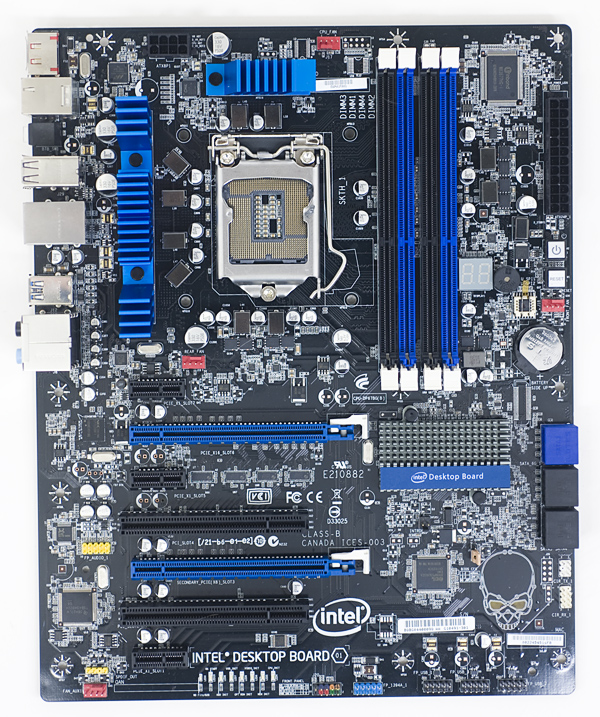
Intel's DP67BG—The blue SATA ports on the right are 6Gbps, the black ones are 3Gbps
To meet the soon to be growing need for 6Gbps SATA ports Intel outfits the 6-series PCH with two 6Gbps SATA ports in addition to its four 3Gbps SATA ports.
I dusted off my 128GB RealSSD C300 and ran it through a bunch of tests on five different platforms: Intel’s X58 (3Gbps), Intel’s P67 (3Gbps and 6Gbps), AMD’s 890GX (6Gbps) and Intel’s X58 with a Marvell 9128 6Gbps SATA controller. The Marvell 91xx controller is what you’ll find on most 5-series motherboards with 6Gbps SATA support.
I ran sequential read/write and random read/write tests, at a queue depth of 32 to really stress the limits of each chipset’s SATA protocol implementation. I ran the sequential tests for a minute straight and the random tests for three minutes. I tested a multitude of block sizes ranging from 512-bytes all the way up to 32KB. All transfers were 4KB aligned to simulate access in a modern OS. Each benchmark started at LBA 0 and was allowed to use the entire LBA space for accesses. The SSD was TRIMed between runs involving writes.
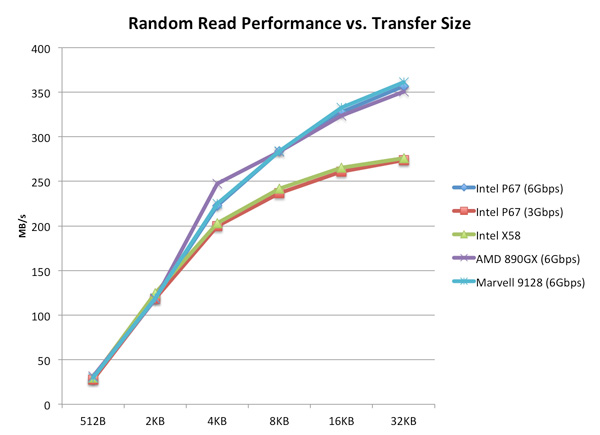
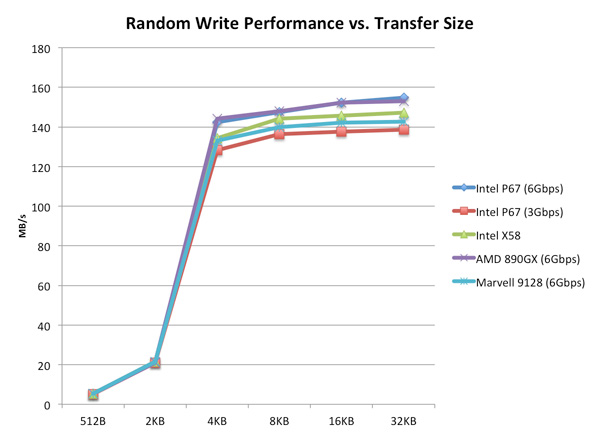
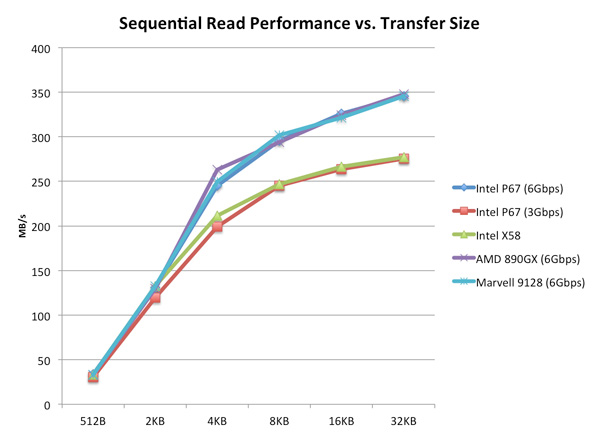
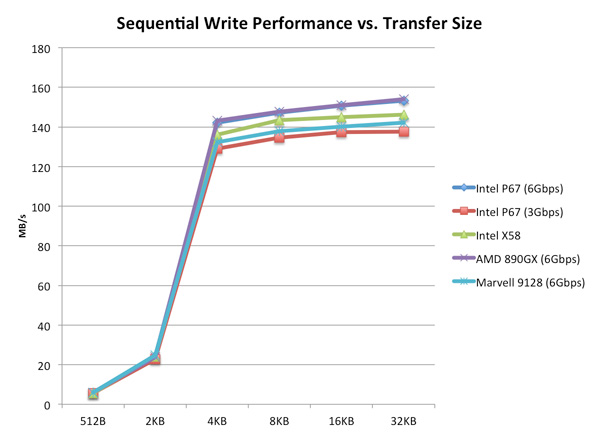
Among Intel chipsets I found that the X58 has stellar 3Gbps SATA performance, which is why I standardize on it for my SSD testbed. Even compared to the new 6-series platform there are slight advantages at high queue depths to the X58 vs. Intel’s latest chipsets.
Looking at 6Gbps performance though there’s no comparison, the X58 is dated in this respect. Thankfully all of the contenders do well in our 6Gbps tests. AMD’s 8-series platform is a bit faster at certain block sizes but for the most part it, Intel’s 6-series and Marvell’s 91xx controllers perform identically.
I hate to be a bore but when it comes to SATA controllers an uneventful experience is probably the best you can hope for.


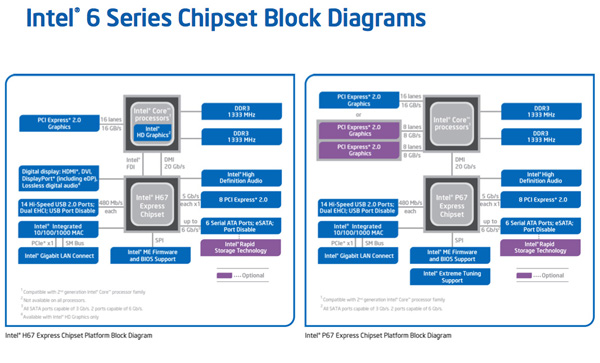








283 Comments
View All Comments
-=Hulk=- - Monday, January 3, 2011 - link
That's crazy, are the chipsets PCI-e line still limited to v1 (250MB/s) speed or what????http://images.anandtech.com/reviews/cpu/intel/sand...
mino - Monday, January 3, 2011 - link
No, you read it wrong.There are altogether 8 PCIE 2.0 linex and all can be used independently, aka s as "PCIe x1".
The CPU-Chipset bandwith however is a basic PCIe x4 link, so do not expect wonders is more divices are in heavy use ...
-=Hulk=- - Monday, January 3, 2011 - link
No!Look at the PCI-e x16 from the CPU. Intel indicates a bandwidth of 16GB/s per line. That means 1GB/s per line.
But PCI-e v2 has a bandwidth of 500MB/s per line only. Thats mean that the values that Intel Indicates for the PCI-e lines are the sum of the upload AND download bandwidth of the PCI-e.
Thats means that the PCI-e lines of the chipset run at 250MB/s speed! That is the bandwidth of the PCI-e v1, and Intel has done the same bullshit with the P55/H57, he indicates that they are PCI-e v2 but they limits their speed to the values of the PCI-e v1:
P55 chipset (look at the 2.5GT/s !!!) :
"PCI Express* 2.0 interface:
Offers up to 2.5GT/s for fast access to peripheral devices and networking with up to 8 PCI Express* 2.0 x1 ports, configurable as x2 and x4 depending on motherboard designs.
http://www.intel.com/products/desktop/chipsets/p55... "
P55, also 500MB/s per line as for the P67
http://benchmarkreviews.com/images/reviews/motherb...
Even for the ancient ICH7 Intel indicates 500MB/s per line, but at that time PCI-e v didn't even exist... That's because it's le sum of the upload and download speed of the PCI-e v1.
http://img.tomshardware.com/us/2007/01/03/the_sout...
DanNeely - Monday, January 3, 2011 - link
Because 2.0 speed for the southbridge lanes has been reported repeatedly (along with a 2x speed DMI bus to connect them), my guess is an error when making the slides with bidirectional BW listed on the CPU and unidirectional BW on the southbridge.jmunjr - Monday, January 3, 2011 - link
Intel's sell out to big media and putting DRM in Sandy Bridge means I won't be getting one of these puppies. I don't care how fast it is...Exodite - Monday, January 3, 2011 - link
Uh, what exactly are you referencing?If it's TXT it's worth noting that the interesting chips, the 2500K and 2600K, doesn't even support it.
chirpy chirpy - Tuesday, January 11, 2011 - link
I think the OP is referring to Intel Insider, the not-so-secret DRM built into the sandy bridge chips. I can't believe people are overlooking the fact that Intel is attempting to introduce DRM at the CPU level and all everyone has to say is "wow, I can't WAIT to get one of dem shiny new uber fast Sandy Bridges!"I for one applaud and welcome our benevolent DRM overlords.....
http://www.pcmag.com/article2/0,2817,2375215,00.as...
nuudles - Monday, January 3, 2011 - link
I have a q9400, if I compare it to the 2500K in bench and average (straight average) all scores the 2500K is 50% faster. The 2500K has a 24% faster base clock, so all the architecture improvements plus faster RAM, more cache and turbo mode gained only ~20% or so on average, which is decent but not awesome taking into account the c2q is 3+ year old design (or is it 4 years?). I know that the idle power is significantly lower due to power gating so due to hurry up and wait it consumes less power (cant remember c2q 45nm load power, but it was not much higher than this core 2011 chips).So 50%+ faster sounds good (both chips occupy the same price bracket), but after equating clock speeds (yes it would increase load and idle power on the c2q) the improvement is not massive but still noticeable.
I will be holding out for Bulldozer (possibly slightly slower, especially in lightly threaded workloads?) or Ivy Bridge as mine is still fast enough to do what I want, rather spend the money on adding a SSD or better graphics card.
7Enigma - Monday, January 3, 2011 - link
I think the issue with the latest launch is the complete and utter lack of competition for what you are asking. Anand's showed that the OC'ing headroom for these chips are fantastic.....and due to the thermals even possible (though not recommended by me personally) on the stock low-profile heatsink.That tells you that they could have significantly increased the performance of this entire line of chips but why should they when there is no competition in sight for the near future (let's ALL hope AMD really produces a winner in the next release) or we're going to be dealing with a plodding approach with INTEL for a while. In a couple months when the gap shrinks (again hopefully by a lot) they simply release a "new" batch with slightly higher turbo frequencies (no need to up the base clocks as this would only hurt power consumption with little/no upside), and bam they get essentially a "free" release.
It stinks as a consumer, but honestly probably hurts us enthusiasts the least since most of us are going to OC these anyways if purchasing the unlocked chips.
I'm still on a C2D @ 3.85GHz but I'm mainly a gamer. In a year or so I'll probably jump on the respin of SDB with even better thermals/OC potential.
DanNeely - Monday, January 3, 2011 - link
CPUs need to be stable in Joe Sixpack's unairconditioned trailer in Alabama during August after the heatsink is crusted in cigarette tar and dust, in one of the horrible computer desks that stuff the tower into a cupboard with just enough open space in the back for wires to get out; not just in an 70F room where all the dust is blown out regularly and the computer has good airflow. Unless something other than temperature is the limiting factor on OC headroom that means that large amounts of OCing can be done easily by those of us who take care of their systems.Since Joe also wants to get 8 or 10 years out of his computer before replacing it the voltages need to be kept low enough that electromigration doesn't kill the chip after 3 or 4. Again that's something that most of us don't need to worry about much.